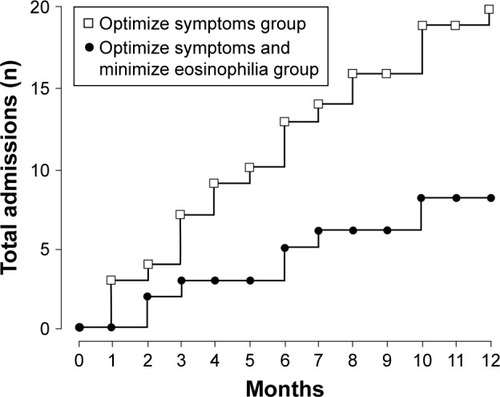Notes: Patients treated to optimize symptoms only (□; n=11); and those treated to optimize symptoms and minimize airway eosinophil inflammation (minimize eosinophilia, keeping sputum eosinophil at <3%) (•; n=12). For patients in the optimize symptoms only group, the hierarchy of treatment was short-acting β
2-agonist, regular anticholinergic, LABA, LAMA, theophylline, and then a trial with a nebulizer; inhaled corticosteroids continued at the same dosage if the patient was already receiving them. For patients in the optimize symptoms and minimize sputum eosinophils group, treatment hierarchy was the same as above. However, patients received the smallest appropriate dosage of anti-inflammatory treatment (ICS or oral CS) to keep sputum eosinophil counts <3%; if eosinophil counts were >3%, then anti-inflammatory treatment was increased. Reproduced with permission of the European Respiratory Society from Siva R, Green RH, Brightling CE, et al. Eosinophilic airway inflammation and exacerbations of COPD: a randomised controlled trial.
Eur Respir J. 2007;29(5):906–913.
Citation78 [Disclaimer: This material has not been reviewed prior to release; therefore, the European Respiratory Society may not be responsible for any errors, omissions, or inaccuracies, or for any consequences arising there from, in the content.]
Abbreviations: CS, corticosteroid; ICS, inhaled corticosteroid; LABA, long-acting β-agonist; LAMA, long-acting muscarinic antagonist.


